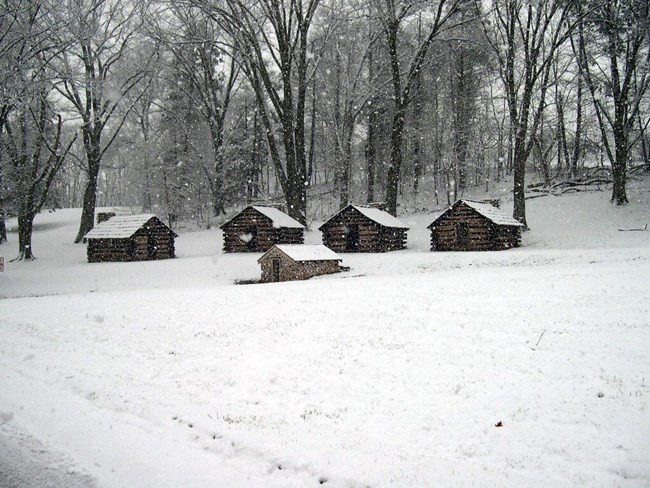Part of a series of articles titled Creative Teaching with Historic Places: Selections from CRM Vol 23 no 8 (2000).
Article
Sources, Sites, and Standards

Published by the National Park Service, Cultural Resources
by Lee Ann Potter
Forget Disney World – growing up, the vacations my family took were to places such as Valley Forge. I never really appreciated this, however, until years later when I was teaching US history at a high school in Houston, Texas, and we were studying the American Revolution. I wanted to convey to my students the commitment of those who fought for independence. One of the ways I thought this could be achieved was by studying the harsh conditions that General George Washington and his troops endured at Valley Forge and asking my students whether they could imagine being so committed to a cause that they would endure similar conditions. Much to my surprise, a few of my students had never actually seen snow, let alone visited Valley Forge or suffered from severe cold. So asking them to imagine what a Continental soldier was exposed to was like asking them to imagine being on Mars. Fortunately, by studying historical maps, letters, and weather information about Valley Forge – and asking my students to hold on to ice cubes and listed to my description of the historical park – I was able to successfully get my point across.
This experience made it clear that combining analysis of primary source documents and the study of historic places related to major themes in the curriculum gets students excited about history, engages them in direct historical inquiry, and deepens their understanding of the theme. In addition, studying documents and places helps students integrate historical thinking and understanding, which is at the core of the National Standards for United States History. Fortunately, the National Archives’ education program and the National Park Service’s Teaching with Historic Places (TwHP) program make primary source documents and historic places easily accessible to educators.
Documents and places motivate students to study history by engaging them in direct historical inquiry. During a recent conference for professional educators, National Park Service historian Beth Boland and I conducted a workshop entitled “Sources, Sites, and Standards” in which we introduced participants to primary sources from the National Archives and sites in the National Register of Historic Places that related to specific themes identified in the National Standards for United States History. Woman suffrage, slavery, westward expansion, and the age of invention were the themes we addressed. In the first activity, we divided the teachers into the four theme groups and distributed to each group a facsimile of a historical document from the holdings of the National Archives (the judgement in the Dred Scott Case, the first Homestead application, an 1871 petition to Congress about woman suffrage, and Edison’s patent drawing for the incandescent light bulb). We asked them to identify their document and determine when it was created, who created it, and what topic (or topics) in US history it relates to. There was much activity and enthusiastic discussion among the teachers as they began to analyze the documents. Each group successfully identified its document and generated expansive lists of topics. When we asked representatives from each group to describe their documents and report on their list of topics, the group with the petition said their document could be used to teach about the First Amendment, woman suffrage, and Reconstruction. In addition, this analysis activity prompted the teachers to ask many questions about the historical content revealed in the documents, from the simple, “Is this really Thomas Edison’s signature?” to the more complex, “If the judgement refers to the circuit court case, can you explain the relationship between the Supreme Court and the lower courts?”
Succeeding activities illustrated how analyzing documents and places can deepen one’s understanding of historical themes. We asked the teachers to use their imaginations to brainstorm places associated with each of the documents they had been studying. The lists they generated were appropriate and in some cases unexpected. For example, the group studying the judgement listed the states and territories associated with Dred Scott, as well as Washington, DC where the judgement was handed down. They did not, however, include the Old Courthouse in St. Louis, where the case began. Since the courthouse is a National Park Service site, we showed them a photograph of it and described its significance.
In the next activity, we showed the teachers a series of photographs depicting various other historic sites and led them through an analysis of each one, beginning with a photograph of the Johnstown, Pennsylvania cemetery. Without revealing its location, we asked the teachers to describe the cemetery. Most of the teachers concluded that it was a military site due to the uniformity of the headstones. When we asked them to elaborate on why headstones in military cemeteries are often uniform, they explained that battlefield tragedies result in many unidentified bodies that require expedient burials. When we revealed that the site in the photograph was the “Unknown Plot” in Johnstown’s Grandview Cemetery, which holds the bodies of 777 of the 1889 flood’s 2,209 dead, there was an audible “aha” from the teachers.
[…]
As our workshop concluded, we asked the teachers to think about historic places in their communities, consider what related documents might exist, and determine where the documents might be available. We provided the teachers with handouts on locating documents and historic sites, alerted them to internet resources, and encouraged them to teach with documents and historic places.
We were delighted when one of the participants approached us afterward and told us that the workshop had inspired him to return home to Bartelsville, Oklahoma, and collaborate with officials from the oldest and largest oil field in Oklahoma on a project for his students.
At the time of publication, Lee Ann Potter was an education specialist with the National Archives and Records Administration.
Last updated: July 2, 2019
